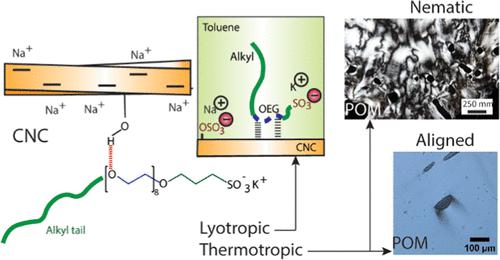当前位置:
X-MOL 学术
›
Biomacromolecules
›
论文详情
Our official English website, www.x-mol.net, welcomes your feedback! (Note: you will need to create a separate account there.)
Controlling the Nematic Liquid Crystallinity of Cellulose Nanocrystals with an Alcohol Ethoxy Sulfonate Surfactant
Biomacromolecules ( IF 6.2 ) Pub Date : 2024-03-20 , DOI: 10.1021/acs.biomac.3c01375 Johanna Majoinen 1, 2 , Lotta Gustavsson 3 , Owies Wani 3 , Samira Kiefer 3 , Ville Liljeström 4 , Orlando J. Rojas 1, 5 , Patrice Rannou 6 , Olli Ikkala 3
Biomacromolecules ( IF 6.2 ) Pub Date : 2024-03-20 , DOI: 10.1021/acs.biomac.3c01375 Johanna Majoinen 1, 2 , Lotta Gustavsson 3 , Owies Wani 3 , Samira Kiefer 3 , Ville Liljeström 4 , Orlando J. Rojas 1, 5 , Patrice Rannou 6 , Olli Ikkala 3
Affiliation

|
Cellulose nanocrystals (CNCs) are biobased colloidal nanorods that have unlocked new opportunities in the area of sustainable functional nanomaterials including structural films and coatings, biomedical devices, energy, sensing, and composite materials. While selective light reflection and sensing develop from the typical chiral nematic (cholesteric, Nem*) liquid crystallinity exhibited by CNCs, a wealth of technologies would benefit from a nematic liquid crystal (LC) with CNC uniaxial alignment. Therefore, this study answers the central question of whether surfactant complexation suppresses CNC chirality in favor of nematic lyotropic and thermotropic liquid crystallinity. Therein, we use a common surfactant having both nonionic and anionic blocks, namely, oligo(ethylene glycol) alkyl-3-sulfopropyl diether potassium salt (an alcohol ethoxy sulfonate (AES)). AES forms complexes with CNCs in toluene (a representative for nonpolar organic solvent) via hydrogen bonding with an AES’ oligo(ethylene glycol) block. A sufficiently high AES weight fraction endows the dispersibility of CNC in toluene. Lyotropic liquid crystallinity with Schlieren textures containing two- and four-point brush defects is observed in polarized optical microscopy (POM), along with the suppression of the cholesteric fingerprint textures. The results suggest a nematic (Nem) phase in toluene. Moreover, thermotropic liquid crystallinity is observed by incorporating an excess of AES, in the absence of an additional solvent and upon mild heating. The Schlieren textures suggest a nematic system that undergoes uniaxial alignment under mild shear. Importantly, replacing AES with a corresponding nonionic surfactant does not lead to liquid crystalline properties, suggesting electrostatic structural control of the charged end group of AES. Overall, we introduce a new avenue to suppress CNC chirality to achieve nematic structures, which resolves the long-sought uniaxial alignment of CNCs in filaments, composite materials, and optical devices.
中文翻译:

用醇乙氧基磺酸盐表面活性剂控制纤维素纳米晶的向列液晶性
纤维素纳米晶体 (CNC) 是一种生物基胶体纳米棒,它为可持续功能纳米材料领域带来了新的机遇,包括结构膜和涂层、生物医学设备、能源、传感和复合材料。虽然选择性光反射和传感是从 CNC 表现出的典型手性向列(胆甾型,Nem*)液晶性发展而来的,但大量技术将受益于具有 CNC 单轴排列的向列液晶 (LC)。因此,本研究回答了表面活性剂络合是否抑制 CNC 手性以有利于向列溶致和热致液晶性的核心问题。其中,我们使用具有非离子和阴离子嵌段的常见表面活性剂,即低聚(乙二醇)烷基-3-磺丙基二醚钾盐(醇乙氧基磺酸盐(AES))。AES 通过与 AES 低聚乙二醇嵌段的氢键作用,在甲苯(非极性有机溶剂的代表)中与 CNC 形成络合物。足够高的 AES 重量分数赋予 CNC 在甲苯中的分散性。在偏光光学显微镜(POM)中观察到具有含有两点和四点刷状缺陷的纹影纹理的溶致液晶性,以及胆甾指纹纹理的抑制。结果表明甲苯中存在向列 (Nem) 相。此外,在不存在额外溶剂且温和加热的情况下,通过掺入过量的AES观察到热致液晶性。纹影纹理表明向列系统在温和剪切下经历单轴排列。重要的是,用相应的非离子表面活性剂代替 AES 不会导致液晶特性,这表明 AES 带电端基的静电结构控制。总体而言,我们引入了一种抑制 CNC 手性以实现向列结构的新途径,这解决了长丝、复合材料和光学器件中 CNC 的单轴对准问题。
更新日期:2024-03-21
中文翻译:

用醇乙氧基磺酸盐表面活性剂控制纤维素纳米晶的向列液晶性
纤维素纳米晶体 (CNC) 是一种生物基胶体纳米棒,它为可持续功能纳米材料领域带来了新的机遇,包括结构膜和涂层、生物医学设备、能源、传感和复合材料。虽然选择性光反射和传感是从 CNC 表现出的典型手性向列(胆甾型,Nem*)液晶性发展而来的,但大量技术将受益于具有 CNC 单轴排列的向列液晶 (LC)。因此,本研究回答了表面活性剂络合是否抑制 CNC 手性以有利于向列溶致和热致液晶性的核心问题。其中,我们使用具有非离子和阴离子嵌段的常见表面活性剂,即低聚(乙二醇)烷基-3-磺丙基二醚钾盐(醇乙氧基磺酸盐(AES))。AES 通过与 AES 低聚乙二醇嵌段的氢键作用,在甲苯(非极性有机溶剂的代表)中与 CNC 形成络合物。足够高的 AES 重量分数赋予 CNC 在甲苯中的分散性。在偏光光学显微镜(POM)中观察到具有含有两点和四点刷状缺陷的纹影纹理的溶致液晶性,以及胆甾指纹纹理的抑制。结果表明甲苯中存在向列 (Nem) 相。此外,在不存在额外溶剂且温和加热的情况下,通过掺入过量的AES观察到热致液晶性。纹影纹理表明向列系统在温和剪切下经历单轴排列。重要的是,用相应的非离子表面活性剂代替 AES 不会导致液晶特性,这表明 AES 带电端基的静电结构控制。总体而言,我们引入了一种抑制 CNC 手性以实现向列结构的新途径,这解决了长丝、复合材料和光学器件中 CNC 的单轴对准问题。



























 京公网安备 11010802027423号
京公网安备 11010802027423号